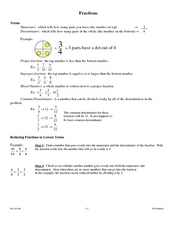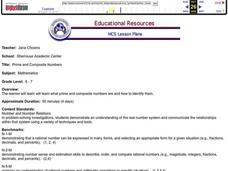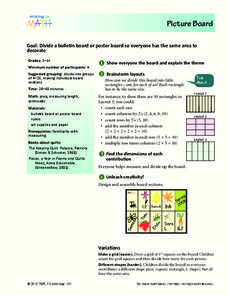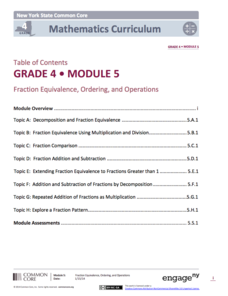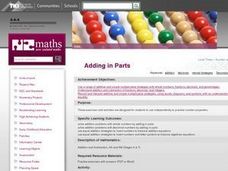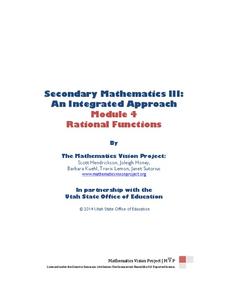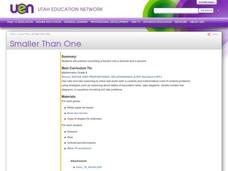Curated OER
Half 1/2
Introduce the concept of fractions to very young children. They see images of objects cut in half. They then complete a series of activities where they color half of each given image, then cut and paste two halves together to create one...
Curated OER
Shape Fractions
Use shapes to visualize fractions! Elementary learners color 1/2, 1/3, 1/4, 1/8, and 1/10 of various shapes. A great addition to your fractions lesson, or to introduce geometry in your math unit.
Curated OER
Introduction to Equivalent Fractions
Explore equivalent fractions! Youngters measure the crown of their head with adding tape labeled with various fractions and fractional parts, and compare strips to notice numerical relationships. They fold adding tape in half and color...
Curated OER
Fractions: Multiplying by Whole Numbers
In this fraction worksheet, students practice multiplying fractions by whole numbers in 30 problems. They can click a box to show the answers if they complete the worksheet online.
Curated OER
How to Read a Ruler
A n incredibly thorough worksheet on how to read and use a ruler awaits yours students. Students identify lines on the ruler and use the proper abbreviations for the lengths. Students answer ten questions about ruler usage.
Curated OER
Fractions Forever!
Middle schoolers identify proper, improper fractions, and mixed numbers. They reduce fractions to their lowest terms. They add and subtract fractions with different denominators, and multiply and divide fractions, as well as...
Curated OER
Addition and Subtraction of Fractions
Learners demonstrate how to solve addition and subtraction of fractions. In this fractions lesson, students use folded paper to shade in fractional parts and identify the sum of the parts shaded.
Curated OER
Parts of a Set
Calling all fraction novices! Use sets of objects to introduce scholars to fractions before they even have learned about numerators and denominators (but this is a great way to introduce these terms!). The first section has four...
Curated OER
Prime and Composite Numbers
Prime and composite numbers are the focus of this mathematics lesson. In it, learners practice techniques for identifying these two types of numbers. They utilize the Inspiration program to complete a task that is clearly explained, and...
Curated OER
Adding Mixed Numbers and Fractions
Once scholars have a grasp on adding fractions, it's time to throw some mixed numbers into the equation! Each of these 14 addition problems has one mixed number and one proper fraction. Skills here include finding a common denominator,...
Curated OER
Picture Board
Learners divide a poster board so everyone gets the same amount of area to decorate. Youngsters talk about the different ways to divide a rectangle. They measure their lines to make sure that each piece is equal and then decorate their...
Curated OER
Introduction to Fractions
With this packet, kids are introduced to fractional concepts by completing 10 pages of exercises. They learn equal and unequal parts, shading fractions, looking at pictures to determine fractions, finding equivalent fractions and finding...
Curated OER
Naming Fractions
Early learners investigate fractions and review the definitions of numerator and denominator on the chalkboard. They complete a "Naming Fractions" worksheet which is included in the lesson.
EngageNY
Fraction Equivalence, Ordering, and Operations
Need a unit to teach fractions to fourth graders? Look no further than this well-developed and thorough set of lessons that takes teachers through all steps of planning, implementing, and assessing their lessons. Divided into eight...
Curated OER
Adding in Parts
Third graders are able to split whole numbers into parts. They make numbers up to a tidy number. Students add and subtract tenths to make a decimals number into a whole number. They are able to add whole numbers up to three digits.
Curated OER
The Multiplier (small 2-digit by 1-digit numbers)
Second graders study digits in 2- or 3-digit whole numbers. They write and solve story problems which involve whole numbers, using addition, subtraction, multiplication, or division.
Curated OER
Flash Fractions 3
Love this! Kids play to practice determining which fraction is larger. Each set of fractions are represented in numeric form as well as how they appear on a fraction circle. This is a great way to show learners the differences between...
California Education Partners
John's Trip Disneyland
It all adds up to one. Pupils solve several items that involve finding sums of fractions in relationship to a whole. The assessment task uses fractions with unlike denominators to determine the amount of a tank of gas and the amount of...
Mathematics Vision Project
Module 4: Rational Functions
Time to study the most sensible function — rational functions! The seven-lesson unit develops the concept of a rational function through a connection to rational numbers and fractions. Scholars graph functions, solve equations, and...
DK Publishing
Part of a Whole
Use segmented shapes to introduce scholars to fractions before they even have learned about numerators and denominators (although this is a great way to introduce these terms!). The first section has four multiple-choice problems:...
Curated OER
Part of a Whole Group
In these two recognizing fractions worksheets, students review examples, observe boxes with two different kinds of things, and use them to write each part as fractions. Next, they circle items to make groups to use to complete number...
Curated OER
Fractions
Students determine that a fraction is a part of a whole or part of a group. They write and read fractions and solve various fraction problems. They create their own fraction problem using colored candies for their classmate to solve.
Curated OER
Unit Fractions Homework 9.1
For this fractions worksheet, students solve 7 problems in which a fraction is written to name the shaded part of a whole. There is one example on the page.
Curated OER
Smaller Than One
Students examine how to convert fractions into decimals and percents. They work with base ten blocks and a worksheet to color in parts of 100 and renaming the parts as decimals and fractions.





